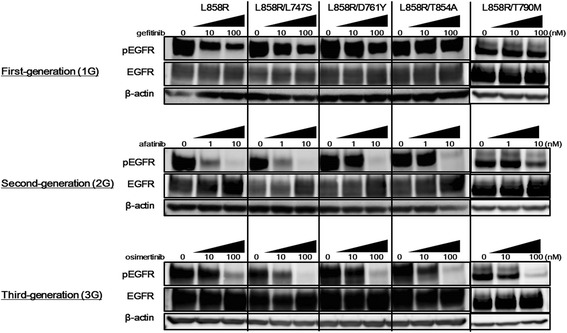Fig. 4.

Western blotting for the EGFR signal. Western blotting was performed using each generation of EGFR-TKI (1G, gefitinib; 2G, afatinib; 3G, osimertinib). The samples were collected at 3 h after stimulation with each EGFR-TKI. When gefitinib was used to inhibit EGFR, the phosphorylation level of EGFR was significantly decreased in the Ba/F3-L858R cell line, compared with the other Ba/F3 cell lines harboring secondary mutations (L858R/L747S, L858R/D761Y, L858R/T854A and L858R/T790 M). In particular, the phosphorylation level of EGFR in the Ba/F3-L858R/T854A cell line was not reduced even by a high concentration of gefitinib (100 nM). Afatinib (2G) reduced the phosphorylation level of EGFR in the Ba/F3-L858R/L747S cell line to an extent similar to that observed in the Ba/F3-L858R cell line. Even in the Ba/F3-L858R/D761Y and Ba/F3-L858R/T854A cell lines, the phosphorylation of EGFR was inhibited by afatinib in a dose-dependent manner. Osimertinib (3G) reduced the phosphorylation level of EGFR in the Ba/F3 cell lines harboring secondary mutations (L858R/L747S, L858R/D761Y, and L858R/T854A) to an extent similar to that observed in the Ba/F3-L858R cell line. β-actin was used as an internal control
